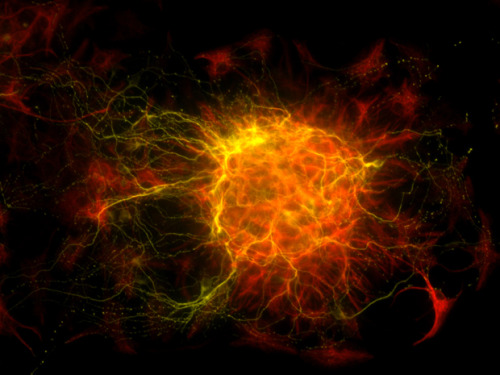Take A Look At This Newly Diagnosed Multiple
Take a look at this newly diagnosed Multiple
Myeloma (MM) case!
MM is a type of cancer developed by the overproduction of plasma cells in the bone marrow (B-cell lineage). Plasma cells are responsible for the production of antibodies to fight infection within the body.
Helpful lab findings
C- hypercalcemia
R- renal failure (increased CREA+BUN)
A- anemia
B- bone lesions
Confirmatory testing
1. Serum protein electrophoresis: spike in the gamma wave aka monoclonal paraprotein (M-spike)
2. Immunofixation protein electrophoresis: identifies the type of immunoglobulin (heavy chain) present (IgA, IgG, [gE, etc.)
3. Free Light Chain Assay: determine if the immuglobulin is
Kappa or Lambda
4. Bone Marrow aspiration: take a look at the first picture.
60% of the bone marrow is most likely plasma cells
Different types of MM
-Smoldering MM (increased plasma cells in bone marrow & high protein. Does NOT follow CRAB)
-MGUS (decreased plasma cells in bone marrow)
-Light chain amyloidosis



More Posts from Invincibleworld and Others
It shifts
Grief
I don’t know how or when
But at some point
The happy memories
Become more of a comfort
Than a pain
Not every day
And not all the time
But some days
Grief shifts




Ammonites were some of the most diverse organisms in the ancient ocean. The Museum holds one of the world’s largest collections of ammonites, containing nearly two million specimens that represent 300 million years of Earth’s history!

#Trichomonas
the deep sea creatures when a scientist shows up with a flashlight outta no where



The Birth of Brain Cells
This might look like a distant web of galaxies captured by a powerful telescope, but it’s actually a microscopic image of a newborn nerve cell. The human brain contains more cells than there are stars in our galaxy, and the most important cells are neurons, which are nerve cells responsible for transmitting and processing electro-chemical signals at up to 320 km/h. This chemical signalling occurs through synapses—specialised connections with other cells, like wires in a computer. Each cell can receive input from thousands of others, so a typical neuron can have up to ten thousand synapses—i.e., can communicate with up to ten thousand other neurons, muscle cells, and glands. Estimates suggest that adult humans have approximately 100 billion neurons in their brain, but unlike most cells, neurons don’t undergo cell division, so if they’re damaged they don’t grow back—except, apparently, in the hippocampus (associated with memory) and the olfactory bulb (associated with sense of smell). The process by which this occurs is unclear, and this image was taken during a project to determine how neurons are born—it actually depicts newborn nerve cells in an adult mouse’s brain.
(Image Credit: Dana Bradford)

A new giant-screen film is on view in the Museum’s LeFrak Theater, starting today! In Turtle Odyssey, discover the wondrous life of a sea turtle named Bunji, from hatchling to adulthood, and the great migration undertaken by generations before her. As this turtle leaves the rookery on the Great Barrier Reef and swims hundreds of miles, she encounters many marine animals—including humpback whales, parrot fish, and even a great white shark—as well as threats to her survival, like plastic waste.
Beat the heat, visit the Museum, and enjoy this immersive giant-screen film on a 40-foot-high, 66-foot-wide screen with state-of-the-art digital sound!



Highway system or fungal contaminants in an in-clinic diffquik stain?
A great example of branching, septate fungal hyphae and why in-clinic cytology dyes should be changed regularly! Fungi love to grow in them and can easily be misinterpreted as pathological!
-
 chopininmind liked this · 3 weeks ago
chopininmind liked this · 3 weeks ago -
 invincibleworld liked this · 3 months ago
invincibleworld liked this · 3 months ago -
 autonomy1 liked this · 4 months ago
autonomy1 liked this · 4 months ago -
 dinosaurwithablog liked this · 5 months ago
dinosaurwithablog liked this · 5 months ago -
 drmh2040 liked this · 6 months ago
drmh2040 liked this · 6 months ago -
 schattenwolf69 liked this · 6 months ago
schattenwolf69 liked this · 6 months ago -
 24-04-toro liked this · 6 months ago
24-04-toro liked this · 6 months ago -
 vital-deloin liked this · 6 months ago
vital-deloin liked this · 6 months ago -
 andrewmbond liked this · 6 months ago
andrewmbond liked this · 6 months ago -
 nandoartee liked this · 6 months ago
nandoartee liked this · 6 months ago -
 meklarian liked this · 6 months ago
meklarian liked this · 6 months ago -
 justanoldfashiontumblog liked this · 6 months ago
justanoldfashiontumblog liked this · 6 months ago -
 u-nobu liked this · 6 months ago
u-nobu liked this · 6 months ago -
 the-eternal-moonshine liked this · 6 months ago
the-eternal-moonshine liked this · 6 months ago -
 ninomeira liked this · 7 months ago
ninomeira liked this · 7 months ago -
 alex--max liked this · 7 months ago
alex--max liked this · 7 months ago -
 dutchs-blog liked this · 7 months ago
dutchs-blog liked this · 7 months ago -
 rodolfo9999 liked this · 7 months ago
rodolfo9999 liked this · 7 months ago -
 paddy0121 liked this · 7 months ago
paddy0121 liked this · 7 months ago -
 invincibleworld reblogged this · 7 months ago
invincibleworld reblogged this · 7 months ago

Science nerd 🧪 | History buff 📜 | Dog & cat person 🐾always curious!
68 posts